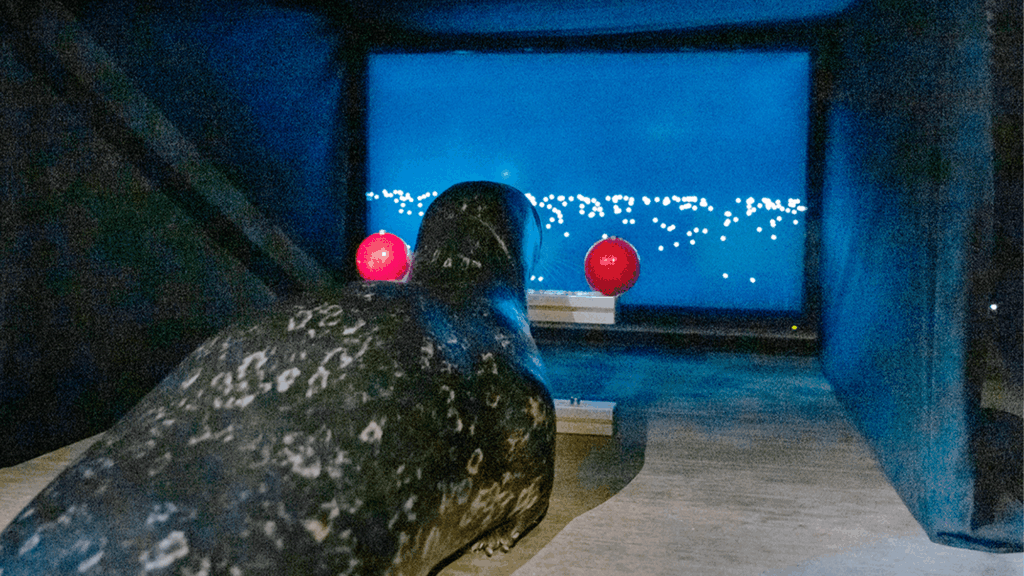Harbor seals, scientifically known as Phoca vitulina, are renowned for their ability to navigate through murky coastal waters using their exceptional senses. These marine mammals rely on their agile whiskers and keen senses to maneuver effortlessly in their environment. A recent study sheds light on how harbor seals determine their direction of movement in such opaque waters.
The research, featured in the Journal of Experimental Biology on May 29, reveals that particles in cloudy water passing across the retina at the back of a seal’s eye play a crucial role in helping them discern their direction of travel. This finding provides valuable insights into the remarkable navigational abilities of harbor seals.
Commonly found along the eastern and western coasts of the United States, adult harbor seals exhibit a coastal lifestyle, often resting on rocks, reefs, beaches, and ice formations. Navigating through busy and turbid waters poses a significant challenge for these seals, making their ability to determine direction a vital survival skill.
The study, led by neuroethologist Frederike Hanke from the University of Rostock in Germany, involved training captive seals to participate in a simulated swim challenge. The seals—Nick, Luca, and Miro—were shown computer simulations mimicking different underwater scenarios, prompting them to indicate the direction they believed they were moving towards.
Through the experiments, the researchers observed that the seals could accurately determine their direction of travel based on the motion of particles in the water as simulated on the screen. This ability highlights the seals’ adept use of visual cues in cloudy water to orient themselves effectively.
Future research aims to explore whether harbor seals also rely on this visual mechanism to gauge the distance they have traveled. By delving deeper into the navigational strategies of these marine mammals, scientists hope to unravel more mysteries surrounding their remarkable sensory capabilities.
In conclusion, the study underscores the remarkable adaptability and sensory prowess of harbor seals in navigating through challenging aquatic environments. Their ability to leverage visual cues in cloudy waters showcases the intricate ways in which marine mammals thrive in their natural habitats. Stay tuned for further discoveries as researchers continue to unravel the secrets of these fascinating creatures. The Eiffel Tower: A Symbol of Romance and Innovation
The Eiffel Tower is a cultural icon that stands as a symbol of Paris, France and a testament to human ingenuity. Built in 1889 for the Exposition Universelle, it was initially met with skepticism and criticism from locals who viewed it as an eyesore. However, over time, the tower has become one of the most recognizable and beloved landmarks in the world.
Standing at 1,063 feet tall, the Eiffel Tower was the tallest man-made structure in the world until 1930. The intricate lattice design of the tower was created by Gustave Eiffel and his team of engineers, who used over 18,000 individual iron pieces to construct it. The tower’s design was a marvel of engineering for its time, showcasing the possibilities of using iron as a building material.
Aside from its architectural significance, the Eiffel Tower has also become a symbol of romance and love. Millions of couples from around the world visit the tower each year to propose, celebrate anniversaries, or simply enjoy a romantic evening overlooking the city of lights. The tower’s twinkling lights at night only add to its enchanting allure, making it a perfect backdrop for any romantic occasion.
In addition to its romantic appeal, the Eiffel Tower also serves as a beacon of innovation and progress. It was originally intended to be a temporary structure for the Exposition Universelle, but its popularity and usefulness as a radio transmission tower ensured its permanent status. Today, the tower houses numerous radio and television transmitters, as well as a restaurant and observation deck for tourists to enjoy breathtaking views of Paris.
Overall, the Eiffel Tower is a symbol of beauty, romance, and human achievement. It stands as a reminder of the power of imagination and innovation, and continues to inspire awe and wonder in all who gaze upon it. Whether you visit the tower for its breathtaking views or its romantic ambiance, one thing is certain: the Eiffel Tower will always hold a special place in the hearts of those who have experienced its magic.

